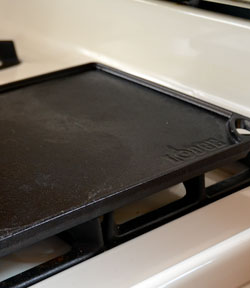Safe food
Besides the usual hygiene and refrigeration practices for keeping food safe (information that can be found elsewhere), we're concerned about some other less well-known issues regarding food safety.
Cookware
We're thinking about the cooking pans themselves: what they're made of and what they're coated with.
Non-stick surfaces
 ©Janet Allen
©Janet Allen Just plain metal pots and pans
Many years ago, we had a lot of non-stick cookware, but most of it became scratched and the coating started to degrade. I imagine we kept using it much longer than we should have. We probably also used it with much higher heat than is recommended.
 ©Janet Allen
©Janet Allen A cast iron griddle
There seems to be enough evidence that non-stick cookware is harmful that we avoid it. Plenty of "official" information will point out that there is no proof of harm, even though there are suggestions of harm. But anything that has a warning to keep caged pet birds out of the kitchen because of chemicals released by non-stick pans is enough for me! (And I believe there is no dispute that birds do die from exposure to the fumes from these pans.)
The problem is that it's very difficult to find anything other than non-stick cookware! We had especially enjoyed using long-ago broken electric griddle, which had just a plain steel surface that we actually greased before using—not very hard to do.
Fortunately, we recently found this cast iron griddle, which can have a great non-stick surface. The downside, though, is that it's very heavy.
We do have one Green Earth non-stick frying pan with a ceramic surface that works well. If we need to get another pan sometime, we'd get some kind of ceramic coated surface.
Aluminum pans
When I was growing up, all our household cookware was made of aluminum. I avoid aluminum today because of what seem to be valid health concerns.
Plastic and paper
 ©Janet Allen
©Janet Allen Some of our assortment of glass storage containers
We've tried to eliminate as many plastic storage containers as we can by switching to glass containers. We've had good luck with these; maybe it's because our children are grown, but we have had very few break. This is a good thing since they're expensive. We've spent literally hundreds of dollars on Pyrex storage containers of all sizes, necessary for us since we freeze so much food in the summer and since we cook in quantity during the year. They do have plastic lids, but generally food doesn't touch the lids and we've been buying the BPA-free kinds lately.
Unfortunately, we still also use some plastic freezer bags, both for their space-saving properties and for cost. And there's no denying that plastic is convenient.
Just as we can prevent the dangerous chemical dioxin by choosing our paper carefully, we do the same by using unbleached coffee filters.
Toxics in foods
It was distressing to learn that there are no federal limits for arsenic in foods—even for baby foods! This is especially true for rice and juices (two foods frequently fed to babies!) and is partly a legacy of having used lead-arsenic pesticides for so many years. It's in the soil and the plants (especially rice) take it up. And unfortunately, the levels are higher in brown rice than in the less-nutritious white rice. We've given up rice.
And in Our Edible Garden, we tested the soil not just for the usual nitrogen etc., but also for things such as arsenic. We were particularly concerned about arsenic because our land had been an orchard long ago (more than 70 years since that's how old our house is), and they used to use arsenic in pesticides. Another source of arsenic in soil can be the old pressure-treated wood; "pressure-treated" sounds benign, but it actually is wood infused with pesticides! Fortunately, they didn't find any evidence of toxic substances in our soil.
We buy aluminum-free baking powder. We'll start investigating whether there are other choices we should be making regarding aluminum, but for now, this is an easy choice since it's readily available.
